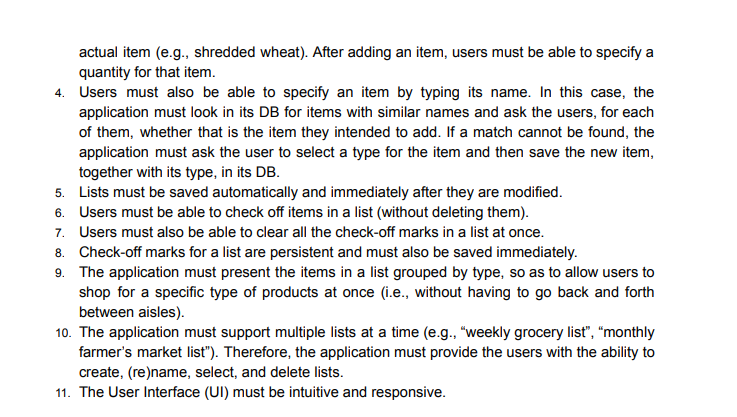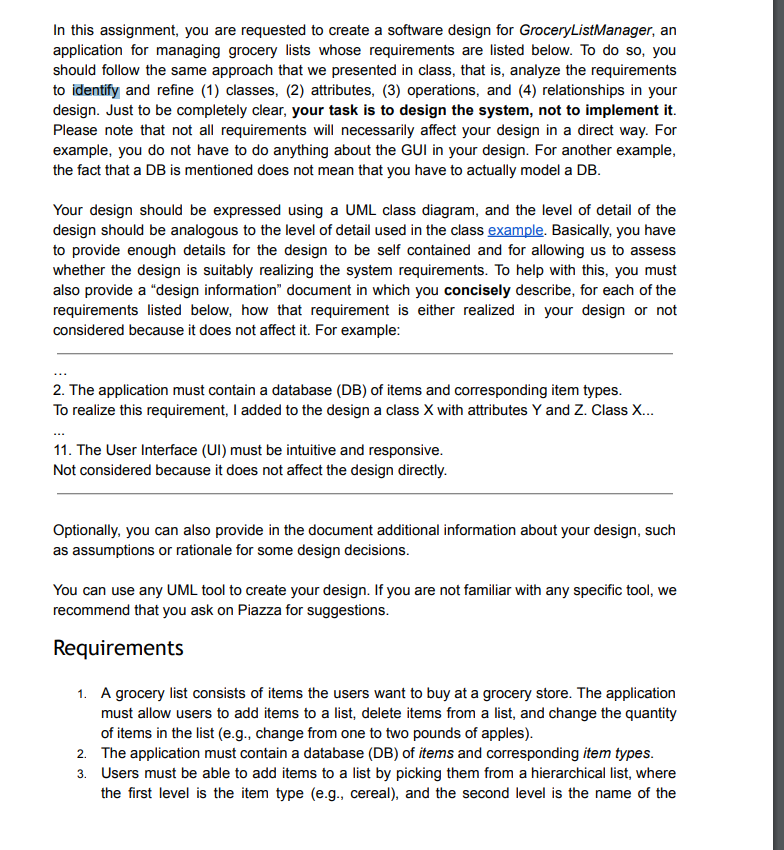In this assignment, you are requested to create a software design for GroceryListManager, an application for managing grocery lists whose requirements are listed below. To do so, you should follow the same approach that we presented in class, that is, analyze the requirements to identify and refine (1) classes, (2) attributes, (3) operations, and (4) relationships in your design. Just to be completely clear, your task is to design the system, not to implement it. Please note that not all requirements will necessarily affect your design in a direct way. For example, you do not have to do anything about the GUI in your design. For another example, the fact that a DB is mentioned does not mean that you have to actually model a DB. Your design should be expressed using a UML class diagram, and the level of detail of the design should be analogous to the level of detail used in the class example. Basically, you have to provide enough details for the design to be self contained and for allowing us to assess whether the design is suitably realizing the system requirements. To help with this, you must also provide a "design information" document in which you concisely describe, for each of the requirements listed below, how that requirement is either realized in your design or not considered because it does not affect it. For example: 2. The application must contain a database (DB) of items and corresponding item types. To realize this requirement, I added to the design a class X with attributes Y and Z. Class X... 11. The User Interface (UI) must be intuitive and responsive. Not considered because it does not affect the design directly. Optionally, you can also provide in the document additional information about your design, such as assumptions or rationale for some design decisions. You can use any UML tool to create your design. If you are not familiar with any specific tool, we recommend that you ask on Piazza for suggestions. Requirements 1. A grocery list consists of items the users want to buy at a grocery store. The application must allow users to add items to a list, delete items from a list, and change the quantity of items in the list (e.g., change from one to two pounds of apples). 2. The application must contain a database (DB) of items and corresponding item types. 3. Users must be able to add items to a list by picking them from a hierarchical list, where the first level is the item type (e.g., cereal), and the second level is the name of the
In this assignment, you are requested to create a software design for GroceryListManager, an application for managing grocery lists whose requirements are listed below. To do so, you should follow the same approach that we presented in class, that is, analyze the requirements to identify and refine (1) classes, (2) attributes, (3) operations, and (4) relationships in your design. Just to be completely clear, your task is to design the system, not to implement it. Please note that not all requirements will necessarily affect your design in a direct way. For example, you do not have to do anything about the GUI in your design. For another example, the fact that a DB is mentioned does not mean that you have to actually model a DB. Your design should be expressed using a UML class diagram, and the level of detail of the design should be analogous to the level of detail used in the class example. Basically, you have to provide enough details for the design to be self contained and for allowing us to assess whether the design is suitably realizing the system requirements. To help with this, you must also provide a "design information" document in which you concisely describe, for each of the requirements listed below, how that requirement is either realized in your design or not considered because it does not affect it. For example: 2. The application must contain a database (DB) of items and corresponding item types. To realize this requirement, I added to the design a class X with attributes Y and Z. Class X... 11. The User Interface (UI) must be intuitive and responsive. Not considered because it does not affect the design directly. Optionally, you can also provide in the document additional information about your design, such as assumptions or rationale for some design decisions. You can use any UML tool to create your design. If you are not familiar with any specific tool, we recommend that you ask on Piazza for suggestions. Requirements 1. A grocery list consists of items the users want to buy at a grocery store. The application must allow users to add items to a list, delete items from a list, and change the quantity of items in the list (e.g., change from one to two pounds of apples). 2. The application must contain a database (DB) of items and corresponding item types. 3. Users must be able to add items to a list by picking them from a hierarchical list, where the first level is the item type (e.g., cereal), and the second level is the name of the
Computer Networking: A Top-Down Approach (7th Edition)
7th Edition
ISBN:9780133594140
Author:James Kurose, Keith Ross
Publisher:James Kurose, Keith Ross
Chapter1: Computer Networks And The Internet
Section: Chapter Questions
Problem R1RQ: What is the difference between a host and an end system? List several different types of end...
Related questions
Question
Please help me with this computer architecture HOMEWORK. Its practice homework with designing, etc.

Transcribed Image Text:actual item (e.g., shredded wheat). After adding an item, users must be able to specify a
quantity for that item.
4. Users must also be able to specify an item by typing its name. In this case, the
application must look in its DB for items with similar names and ask the users, for each
of them, whether that is the item they intended to add. If a match cannot be found, the
application must ask the user to select a type for the item and then save the new item,
together with its type, in its DB.
5. Lists must be saved automatically and immediately after they are modified.
6. Users must be able to check off items in a list (without deleting them).
7. Users must also be able to clear all the check-off marks in a list at once.
8. Check-off marks for a list are persistent and must also be saved immediately.
9. The application must present the items in a list grouped by type, so as to allow users to
shop for a specific type of products at once (i.e., without having to go back and forth
between aisles).
10. The application must support multiple lists at a time (e.g., "weekly grocery list", "monthly
farmer's market list"). Therefore, the application must provide the users with the ability to
create, (re)name, select, and delete lists.
11. The User Interface (UI) must be intuitive and responsive.

Transcribed Image Text:In this assignment, you are requested to create a software design for Grocery ListManager, an
application for managing grocery lists whose requirements are listed below. To do so, you
should follow the same approach that we presented in class, that is, analyze the requirements
to identify and refine (1) classes, (2) attributes, (3) operations, and (4) relationships in your
design. Just to be completely clear, your task is to design the system, not to implement it.
Please note that not all requirements will necessarily affect your design in a direct way. For
example, you do not have to do anything about the GUI in your design. For another example,
the fact that a DB is mentioned does not mean that you have to actually model a DB.
Your design should be expressed using a UML class diagram, and the level of detail of the
design should be analogous to the level of detail used in the class example. Basically, you have
to provide enough details for the design to be self contained and for allowing us to assess
whether the design is suitably realizing the system requirements. To help with this, you must
also provide a "design information" document in which you concisely describe, for each of the
requirements listed below, how that requirement is either realized in your design or not
considered because it does not affect it. For example:
2. The application must contain a database (DB) of items and corresponding item types.
To realize this requirement, I added to the design a class X with attributes Y and Z. Class X...
11. The User Interface (UI) must be intuitive and responsive.
Not considered because it does not affect the design directly.
Optionally, you can also provide in the document additional information about your design, such
as assumptions or rationale for some design decisions.
You can use any UML tool to create your design. If you are not familiar with any specific tool, we
recommend that you ask on Piazza for suggestions.
Requirements
1. A grocery list consists of items the users want to buy at a grocery store. The application
must allow users to add items to a list, delete items from a list, and change the quantity
of items in the list (e.g., change from one to two pounds of apples).
2. The application must contain a database (DB) of items and corresponding item types.
3. Users must be able to add items to a list by picking them from a hierarchical list, where
the first level is the item type (e.g., cereal), and the second level is the name of the
Expert Solution
This question has been solved!
Explore an expertly crafted, step-by-step solution for a thorough understanding of key concepts.
This is a popular solution!
Trending now
This is a popular solution!
Step by step
Solved in 3 steps with 1 images

Knowledge Booster
Learn more about
Need a deep-dive on the concept behind this application? Look no further. Learn more about this topic, computer-engineering and related others by exploring similar questions and additional content below.Recommended textbooks for you

Computer Networking: A Top-Down Approach (7th Edi…
Computer Engineering
ISBN:
9780133594140
Author:
James Kurose, Keith Ross
Publisher:
PEARSON

Computer Organization and Design MIPS Edition, Fi…
Computer Engineering
ISBN:
9780124077263
Author:
David A. Patterson, John L. Hennessy
Publisher:
Elsevier Science

Network+ Guide to Networks (MindTap Course List)
Computer Engineering
ISBN:
9781337569330
Author:
Jill West, Tamara Dean, Jean Andrews
Publisher:
Cengage Learning

Computer Networking: A Top-Down Approach (7th Edi…
Computer Engineering
ISBN:
9780133594140
Author:
James Kurose, Keith Ross
Publisher:
PEARSON

Computer Organization and Design MIPS Edition, Fi…
Computer Engineering
ISBN:
9780124077263
Author:
David A. Patterson, John L. Hennessy
Publisher:
Elsevier Science

Network+ Guide to Networks (MindTap Course List)
Computer Engineering
ISBN:
9781337569330
Author:
Jill West, Tamara Dean, Jean Andrews
Publisher:
Cengage Learning

Concepts of Database Management
Computer Engineering
ISBN:
9781337093422
Author:
Joy L. Starks, Philip J. Pratt, Mary Z. Last
Publisher:
Cengage Learning

Prelude to Programming
Computer Engineering
ISBN:
9780133750423
Author:
VENIT, Stewart
Publisher:
Pearson Education

Sc Business Data Communications and Networking, T…
Computer Engineering
ISBN:
9781119368830
Author:
FITZGERALD
Publisher:
WILEY